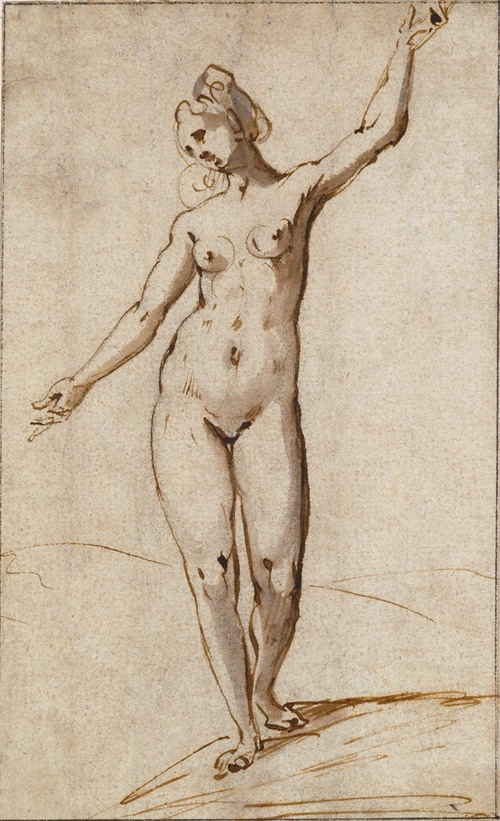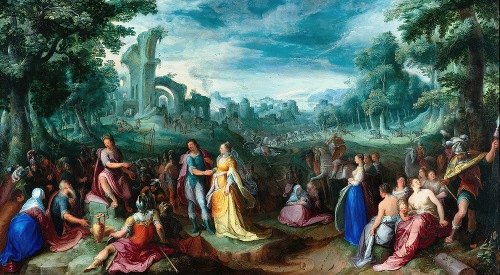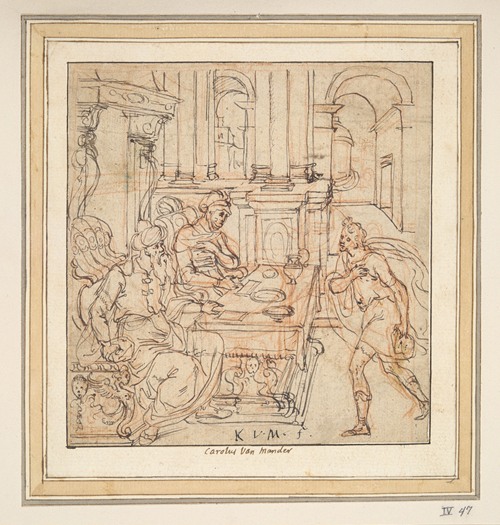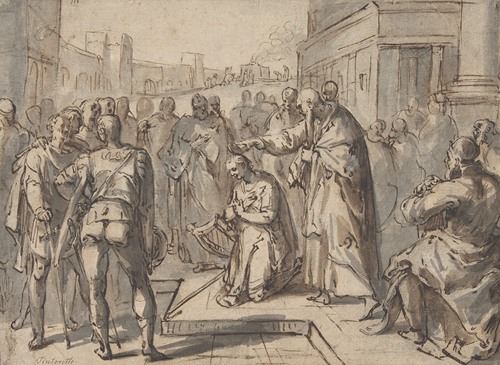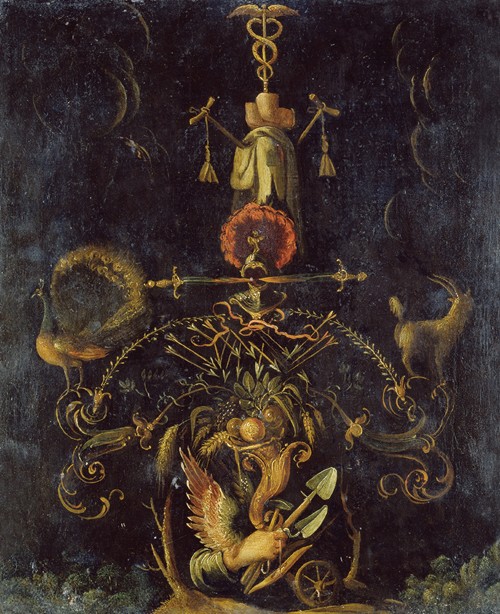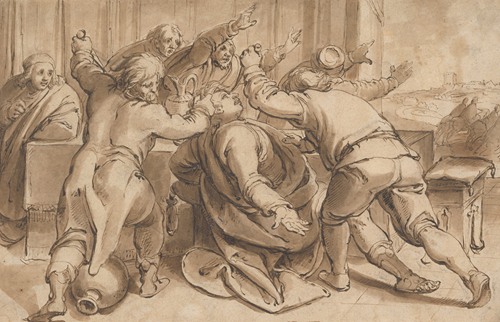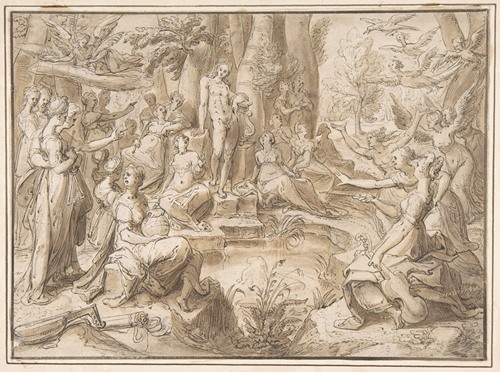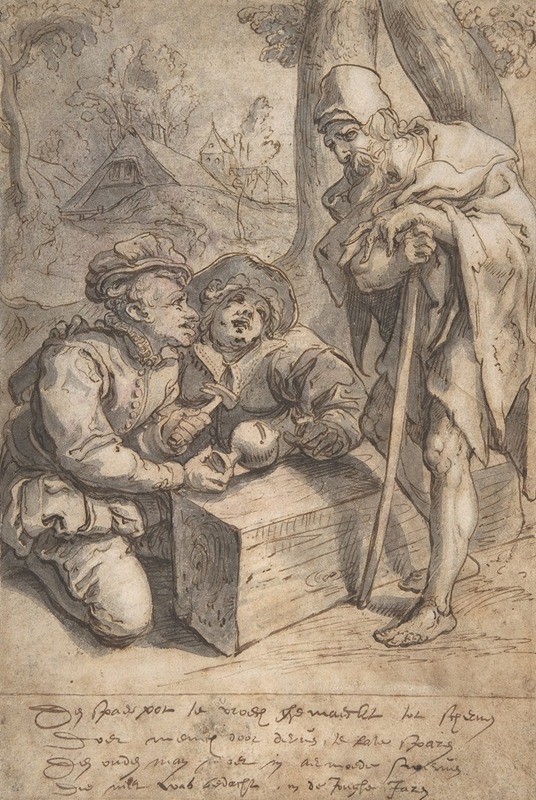
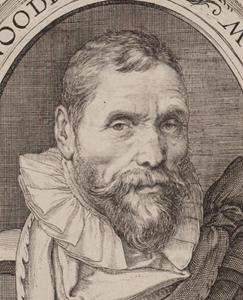
Karel van Mander was a Flemish painter, poet, art historian and art theoretician, who established himself in the Dutch Republic in the latter part of his life. He is mainly remembered as a biographer of Early Netherlandish painters and Northern Renaissance artists in his Schilder-boeck. As an artist and art theoretician he played a significant role in the spread and development of Northern Mannerism in the Dutch Republic.
Most of the information about Karel van Mander's life is based on a brief and anonymous biographical sketch included in the posthumous second edition of the Schilder-boeck published in 1618 by Jacob Pietersz Wachter. It is not certain who wrote this biographical sketch and various candidates have been proposed. Most recently it has been argued that it was written by his son Karel van Mander the Younger. His son would have relied on biographical information that Karel van Mander had written himself as well as on his own recollections and notes. The information in the biographical sketch is not entirely reliable but is still regarded as the best source of information on van Mander's life.
Van Mander was born into a noble family in Meulebeke, in the County of Flanders. He studied under Lucas de Heere in Ghent, and in 1568-1569 under Pieter Vlerick in Kortrijk. The next five years he devoted to the writing of religious plays for which he also painted the scenery. Then followed three years in Rome (1574–1577). His biographical sketch refers to van Mander as the discoverer of 'caves' in Rome. This may be a reference to the Catacombs of Rome although the exact meaning of the reference is unclear. In Rome he may also have come into contact with fellow Fleming Bartholomeus Spranger, who left Rome in 1575 for Vienna to enter into the service of the emperor. His patrons in Rome included several cardinals. On his return journey he passed through Vienna, where, together with Spranger and the sculptor Hans Mont, he made the triumphal arch for the royal entry of the emperor Rudolf II.
Van Mander settled in Meulebeke in 1578 where he was active as a painter and writer. He married an 18-year-old local girl, with whom he had a son. In 1580 he left for Kortrijk due to religious troubles caused by Catholic zealots in Meulebeke. Karel van Mander had at some point become a Mennonite and was therefore a possible target of these zealots. In Kortrijk he got a commission for an altar piece. In Kortrijk another son was born. He left Kortrijk for Bruges in 1582 because of an outbreak of the plague and other reasons. In Bruges, he worked with the painter Paul Weyts. Because of the threat of religious troubles and the plague, Karel fled with his family and his mother-in-law by ship to the Dutch Republic where he settled in Haarlem in the province of Holland in 1583.
Here he worked for 20 years on a commission by the Haarlem city fathers to inventory "their" art collection. The city of Haarlem had confiscated all Catholic religious art after the satisfactie van Haarlem, which gave Catholics equal rights to Protestants, had been overturned in 1578. Van Mander used his work on the commission in his "Schilder-boeck". While in Haarlem he continued to paint, concentrating his energy on his favourite genre: historical allegories. In 1603 he rented a fortified manor ("het Huis te Zevenbergen"), later renamed Kasteel Marquette in Heemskerk to proofread his book that was published in 1604. He died soon after it was published in Amsterdam at the age of 58.
Karel van Mander was the founder, together with Hubertus Goltzius and Cornelis van Haarlem, of an 'academy to study after life'. It is not entirely clear what this academy did but it is believed it was an informal discussion group which may have organised drawing classes with life models. It has also been claimed that the nature of the academy was more of a literary nature.
He had an important impact on art in the Dutch Republic when in 1585 he showed his friend Hendrick Goltzius drawings by Bartholomeus Spranger. Spranger was then the leading artist of Northern Mannerism and was based in Prague as the court artist of emperor Rudolf II. These drawings had a galvanising effect on Goltzius whose style was influenced by them. Goltzius made engravings of the drawings which were important in disseminating the Mannerist style. Van Mander, Goltzius and Cornelis van Haarlem became known as the "Haarlem Mannerists" and artists from other towns joined the movement. Their pictorial language was characterised by a strong awareness of style and cultivated elegance. They strived for artful ingenuity rather than naturalism. They also had a preference for depicting exaggeratedly brawny musclemen, violent drama, wild fantasy and a heightened richness of detail. The dissemination of the engravings of Goltzius went hand in hand with the new practice of art theorisation that was new to the 16th century and in which Karel van Mander played an important role.
He received budding artists in his home for evenings of communal drawing and study of classical mythology. After the iconoclasm of the Calvinists, religious themes had gone out of fashion and mythology had become popular. However, few painters could afford a trip to Italy such as the one that van Mander had undertaken. His purpose was to educate young painters in the proper artistic techniques. He was a firm believer in the hierarchy of genres. It was his firm belief that only through proper study of existing works it was possible to realize true-to-life historical allegories.
His own works included mannerist mythological subjects, but also portraits and genre paintings influenced by Pieter Bruegel the Elder, such as the Kermis in the Hermitage Museum. Relatively few paintings by him survive.

